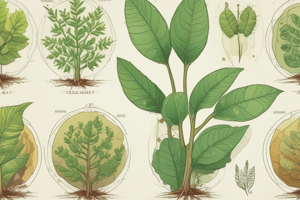Podcast
Questions and Answers
What are the primary products of the light-dependent reactions of photosynthesis?
What are the primary products of the light-dependent reactions of photosynthesis?
- ATP and NADPH (correct)
- Glucose and water
- Carbon dioxide and oxygen
- Oxygen and glucose
In which part of the chloroplast do the light-independent reactions occur?
In which part of the chloroplast do the light-independent reactions occur?
- Thylakoid membranes
- Granum
- Chlorophyll membranes
- Stroma (correct)
Which wavelengths of light does chlorophyll primarily absorb?
Which wavelengths of light does chlorophyll primarily absorb?
- Green and yellow
- Infrared and ultraviolet
- Orange and violet
- Blue and red (correct)
What is the role of chlorophyll in the light-dependent reactions?
What is the role of chlorophyll in the light-dependent reactions?
What is the first step in the light-independent reactions (Calvin Cycle)?
What is the first step in the light-independent reactions (Calvin Cycle)?
Which pigment acts as the primary pigment involved in photosynthesis?
Which pigment acts as the primary pigment involved in photosynthesis?
What byproduct is released during the light-dependent reactions?
What byproduct is released during the light-dependent reactions?
Flashcards are hidden until you start studying
Study Notes
Photosynthesis Stages
-
Light-dependent Reactions
- Occur in the thylakoid membranes of chloroplasts.
- Involve the absorption of sunlight by chlorophyll.
- Water (H2O) is split into oxygen (O2), protons, and electrons.
- ATP and NADPH are produced (energy carriers).
- Oxygen is released as a byproduct.
-
Light-independent Reactions (Calvin Cycle)
- Occur in the stroma of chloroplasts.
- Use ATP and NADPH from light-dependent reactions.
- Fix carbon dioxide (CO2) from the atmosphere into glucose (C6H12O6).
- Involves three main stages: carbon fixation, reduction phase, and regeneration of ribulose bisphosphate (RuBP).
Chlorophyll Role
-
Pigment Function
- Chlorophyll absorbs light primarily in the blue (430-450 nm) and red (640-680 nm) wavelengths.
- Reflects green light (500-550 nm), giving plants their green color.
-
Photosynthesis Catalyst
- Essential for capturing light energy and initiating the light-dependent reactions.
- Plays a key role in the energy conversion process, facilitating the transfer of electrons.
-
Types of Chlorophyll
- Chlorophyll a: Primary pigment involved in photosynthesis.
- Chlorophyll b: Accessory pigment that assists in capturing additional light energy.
Photosynthesis Stages
- Light-dependent reactions occur within thylakoid membranes of chloroplasts.
- Chlorophyll absorbs sunlight, causing the splitting of water (H2O) into oxygen (O2), protons, and electrons.
- The production of ATP and NADPH serves as energy carriers during these reactions.
- Oxygen is generated as a byproduct and released into the atmosphere.
Light-independent Reactions (Calvin Cycle)
- These reactions take place in the stroma of chloroplasts.
- Utilize ATP and NADPH produced in the light-dependent reactions to fix carbon dioxide (CO2) into glucose (C6H12O6).
- The Calvin Cycle involves three key stages: carbon fixation, reduction phase, and regeneration of ribulose bisphosphate (RuBP).
Chlorophyll Role
- Chlorophyll acts as a pigment that absorbs light primarily in the blue (430-450 nm) and red (640-680 nm) wavelengths, reflecting green light (500-550 nm).
- This reflection is responsible for the green color of plants.
Photosynthesis Catalyst
- Chlorophyll is vital for capturing light energy, initiating the light-dependent reactions, and facilitating electron transfer.
Types of Chlorophyll
- Chlorophyll a is the primary pigment essential for photosynthesis.
- Chlorophyll b acts as an accessory pigment, helping in the absorption of additional light energy.
Studying That Suits You
Use AI to generate personalized quizzes and flashcards to suit your learning preferences.




